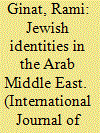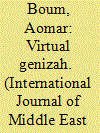| Srl | Item |
| 1 |
ID:
133308


|
|
|
|
|
| Publication |
2014.
|
| Summary/Abstract |
Much work has been done in recent decades on the histories of the Jews of Arab lands across a variety of time periods, reflecting an increasing interest in the historical past of the Jews of the "Orient." While diverse, this literature may be divided into several general groups. The first comprises studies written by Western and Israeli scholars and encompasses a broad spectrum of Arabic-speaking countries. This literature has explored, among other things, issues relating to the way of life and administration of ethnically and culturally diverse Jewish communities, their approaches to Zionism and the question of their national identities, their positions regarding the Zionist-Israeli-Arab conflict in its various phases, and the phenomena of anti-Semitism, particularly in light of the increasing escalation of the conflict. It includes works by Israeli intellectuals of Mizrahi heritage, some of whom came together in the late 1990s in a sociopolitical dissident movement known as the Mizrahi Democratic Rainbow Coalition. The target audience of this movement was Mizrahi Jews: refugees and emigrants from Arab countries as well as their second- and third-generation offspring. The movement, which was not ideologically homogeneous (particularly regarding approaches to the resolution of the Israeli-Palestinian conflict), took a postcolonialist approach to the Zionist narrative and enterprise, and was critical of the entrenchment of the Ashkenazi (European-extraction) Jews among the elites of the emerging Israeli society. The movement had scant success in reaching its target population: the majority of Mizrahi/Sephardi Jews living in Israel. Nevertheless, it brought to the fore the historical socioeconomic injustices that many Jews from Arab countries had experienced since arriving in Israel, whether reluctantly or acquiescently.
|
|
|
|
|
|
|
|
|
|
|
|
|
|
|
|
| 2 |
ID:
133310


|
|
|
|
|
| Publication |
2014.
|
| Summary/Abstract |
After the establishment of the State of Israel, the Zionist narrative dominated the histories and historiographies of Middle Eastern and North African Jewries. Accordingly, Jews and Arabs were largely kept as distinct binaries divided by the intellectual walls that separated Middle East studies and Jewish studies programs. Local North African and Middle Eastern scholars also silenced or overlooked the Jewish dimension of Middle Eastern societies in the same manner that Israeli scholars ignored the historical connections between Arabs and Jews that existed both before and after 1948. The exclusive, sacred yet ebbing, nationalist paradigm has been plagued with historiographical fissures in recent decades, allowing a new wave of intellectual engagement by a young generation of Jewish and Muslim scholars who began to put the Jew and the Arab back into local and global histories formed through complex social, cultural, economic, and political networks.
|
|
|
|
|
|
|
|
|
|
|
|
|
|
|
|